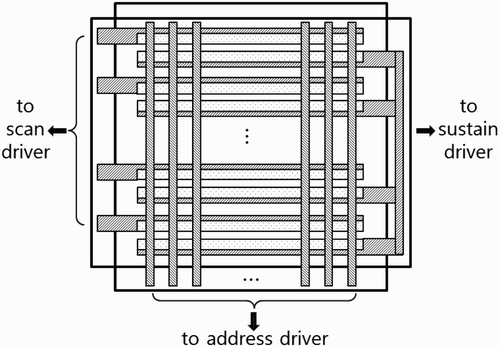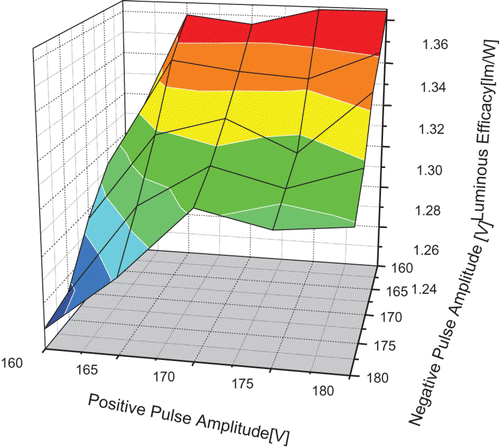Abstract
It was reported that the discharge characteristics of an AC plasma display panel (PDP) with a single sustainer, which is sustained by the successive application of bipolar pulses, are different from those with a conventional driver. The luminous efficacy of an AC PDP with a single sustainer increases with increased sustain voltage, whereas the conventional PDP shows the opposite trend, resulting from the dependence of the luminous efficacy on the polarity of the sustain pulse. In this study, the IR emission efficiency was analyzed to determine the dependence on the polarities of the sustain pulses. The IR emission efficiency showed dependence on the amplitude of the sustain pulse with opposite polarities, which provided a motive to optimize the sustain pulse amplitude in each polarity of the sustain pulse. The luminous efficacy in an AC PDP with a single sustainer increased with increasing positive-going pulse amplitude, and decreased as the negative-going pulse amplitude increased. The optimal sustain can be obtained under the condition where the positive-going pulse amplitude is high and the negative-going pulse amplitude is low. As a result, a 5% higher luminous efficacy can be achieved when the maximum positive and minimum negative sustain voltages are used than when equal positive and minimum negative sustain voltages are used.
1. Introduction
Plasma display panels (PDPs) have many advantages in realizing large flat displays with a simpler process and a shorter lead time compared with other display devices. The lower luminous efficacy and high voltage circuit of PDPs, however, block them from securing competitiveness over other display devices. To improve their luminous efficacy, various cell structures were examined Citation1–3. On the other hand, a new driving technology was introduced to reduce the circuitry cost by simplifying the driving circuit structure Citation4–6, in which positive- and negative-going pulses were applied alternately to one group of sustain electrodes, while the other group of sustain electrodes was maintained at ground level. In the conventional sustain driving method, monopolar pulses are alternately applied to two groups of sustain electrodes, and two sustain circuit boards are required. The maintenance of a constant voltage level for one group of sustain electrodes in single-sustainer driving, however, will lead to the exclusion of the sustain circuit board. In single-sustainer driving, which applies bipolar sustain pulses to one group of sustain electrodes while the other group is maintained at ground voltage level, cost-effectiveness can be achieved. Although the operation and discharge characteristics were observed in the previous works Citation4 Citation6, the optimization of the operating condition to achieve luminous efficacy has not been investigated. In this study, the amplitude of each polarity of the sustain pulses was varied, and the variations of the luminance and luminous efficacy were observed to achieve better performance.
2. Experiment setup
In this work, a 2-in diagonal test panel was used. The cell pitch of the panel that was used in the experiment was 1080 μm, and the typical barrier rib height was 160 μm. The sustain and scan electrodes had the same width (100 μm) and faced each other, with separation of the 80 μm discharge gap. The e-beam evaporated the 4000 Å MgO thin film that was deposited on the 40-μm-thick dielectric layer covering the sustain and scan electrodes in the front plate, and a 20-μm-thick green phosphor layer was deposited on the barrier rib. The sealed panel was filled with 53.3 kPa of Ne–4%Xe discharge gas.
shows the schematic of the PDP cell and its connection to the driving circuits to apply operation pulses. In this study, the sustain electrodes shown at the right side of the panel, and the address electrodes shown at bottom, were maintained at ground voltage level, and the bipolar pulses, which were consecutive alternating positive- and negative-going sustain pulses, were applied only to the scan electrode group shown on the left side of the panel, to observe the sustain discharge characteristics of single-sustainer driving. Positive-going sustain pulses were applied alternately to the groups of sustain and scan electrodes in the conventional PDP operation.
3. Results and discussion
In the previous study, it was reported that the spatiotemporal distribution of the Xe excited species and the discharge paths are varied by the polarity of the bipolar sustain pulses due to the influence of the address electrode Citation4. Thus, it can be assumed that the applied sustain pulse polarity also affects the luminous efficacy of PDPs. In this study, in relation to the luminous efficacy, the IR emission efficacy was observed with the variation of the sustain pulse amplitude. presents the results of the analysis of the variation of the IR efficiency with the changes in the sustain pulse amplitude in single-sustainer driving. The time evolution of the IR spectral intensity was measured using a photosensor amplifier (Hamamatsu C6386, Japan) and was integrated during each positive- and negative-going pulse application. The discharge current amount was also measured by subtracting the integrated displacement current from the integrated total discharge current during each positive- or negative-going pulse application, using an oscilloscope. The IR emission efficacy was calculated based on the ratio of the IR emission to the discharge current multiplied by the sustain voltage, which is not a direct method of determining the luminous efficacy of the PDP but enables the distinction of the different luminous efficacy trends by applying the positive- and negative-going pulses Citation4. In , the IR emission and power consumption increase with increasing positive-going sustain pulse amplitude. The increment ratio of the IR emission is larger than that of the power consumption, however, and the IR emission efficiency increased with the increase in positive-going sustain pulse amplitude. In , on the contrary, the IR emission shows a small increment with increasing negative-going sustain pulse amplitude while the power consumption increased in larger amounts. As a result, it can be said that the IR emission efficiency decreases with the increase in negative-going sustain pulse amplitude. The different IR emission efficiency trends in the different polarities of the sustain pulses are assumed to be related to the discharge characteristics in the single-sustainer driving of an AC PDP. It is assumed that the expansion of the discharge volume by the negative-going sustain pulse, which has a dominant discharge component in the vertical direction, is limited by the address electrode, and that the IR emission is also limited notwithstanding the increased discharge power with increasing sustain pulse amplitude.
Figure 2. Variation of the IR emission efficiency with the changes in the amplitudes of the (a) positive-going and (b) negative-going sustain pulses.
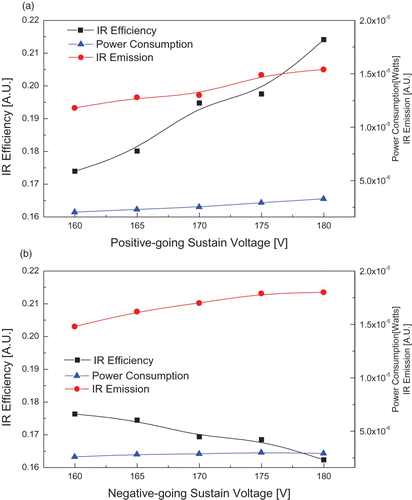
The results of the IR efficiency analysis of the polarity of the sustain pulses when the same amplitudes of positive- and negative-going pulses were used present a need to optimize the sustain pulse amplitude for the effective operation of a PDP with single-sustainer driving. To determine the optimal sustain condition, the changes in the operation characteristics were observed with the variation of the amplitudes of the positive- and negative-going sustain pulses, as shown in . The rising and falling times of the positive- and negative-going sustain pulses were typically 70 and 60 ns, respectively. and presents the changes in the luminance and power consumption with the variation of the amplitudes of the positive- and negative-going sustain pulses while the negative- and positive-going sustain pulse amplitudes were fixed, respectively. The dotted lines in present the luminance and power consumption when the positive- and negative-going pulse amplitudes were the same. In both cases, the luminance increased with increasing sustain pulse amplitude. The increment of power consumption with increasing sustain pulse amplitude, however, was larger in the case where the negative-going sustain pulse amplitude increased Citation4 Citation6.
Figure 3. Schematic of the sustain waveforms of each electrode (the positive and negative pulse amplitudes were varied).

Figure 4. Changes in luminance and power consumption with the variation of the amplitude of the (a) positive-going and (b) negative-going sustain pulses when the negative- and positive-going sustain pulse amplitudes were fixed, respectively.
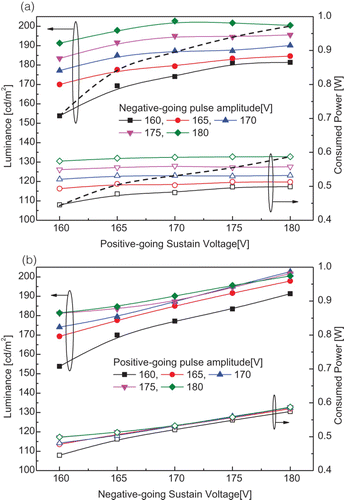
As a consequence of the variation of the luminance and power consumption, the changes in the luminous efficacy showed different trends with varying amplitudes of the negative- and positive-going sustain pulses. shows that the luminous efficacy increased with increasing positive-going sustain pulse amplitude in each fixed negative-going sustain pulse amplitude. On the contrary, the luminous efficacy is shown in to have decreased with increasing negative-going sustain pulse amplitude in each fixed positive-going sustain pulse amplitude. In the previous study, it was reported that the discharge by negative-going sustain pulse application extended in the vicinity of the address electrode because the other sustain electrodes and the address electrode in the ground potentially act as anodes Citation4. Thus, it is assumed that an increase in negative-going sustain pulse amplitude will result in a rapid increase in power consumption due to the charged-particle loss to the address electrode and the limited expansion of the discharge volume.
Figure 5. Changes in the luminous efficacy with the variation of the amplitude of the (a) positive-going and (b) negative-going sustain pulses when the negative- and positive-going sustain pulse amplitudes were fixed, respectively.
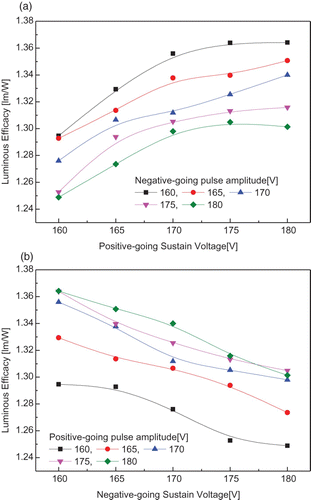
The optimal sustain condition in single-sustainer driving can be determined by plotting three-dimensional plots of luminance and luminous efficacy, as shown in . shows that the luminous efficacy increases when it is sustained with a high-voltage positive-going pulse and a low-voltage positive-going pulse. In case luminance is not a critical issue, it is regarded as the optimal condition of single-sustainer driving to sustain a high-voltage positive-going pulse and a low-voltage positive-going pulse within the sustain margin. As a result, a 5% higher luminous efficacy can be achieved when the maximum positive and minimum negative sustain voltages are used (V s =−160/180 V) than when equal positive and minimum negative sustain voltages are used V s =−160/160 V).
4. Conclusions
In the analysis of the IR emission, the emission efficiency showed different trends with varying amplitudes of the opposite polarities of the sustain pulses; the IR emission efficiency increased with increasing positive-going sustain pulse amplitude, but decreased when the negative-going pulse amplitude increased. It is assumed that this phenomenon resulted from the different characteristics of the discharge induced by the opposite polarities of the sustain pulses. Both the IR emission and power consumption increased with increasing sustain pulse amplitude with both polarities. The increment ratio of power consumption with increasing sustain pulse amplitude, however, was larger than that of the IR emission when the amplitude of the negative-going sustain pulse increased with a fixed positive-going sustain voltage. As a result, the IR emission efficiency increased with increasing positive-going sustain pulse amplitude and decreasing negative-going pulse amplitude.
Based on the IR emission efficiency analysis, the amplitudes of sustain pulses with opposite polarities were varied separately to optimize the sustain operation condition in single-sustainer driving. The luminance increased when the sustain pulse amplitudes increased, regardless of their polarity, but a high luminous efficacy was observed in the high positive-going and low negative-going sustain voltage operation, as in the IR emission analysis.
Acknowledgements
This study was financially supported by Seoul National University of Science and Technology.
References
- Bae , H. S. , Kim , T. J. , Jeong , D. C. and Whang , K.-W. 2006 . IEEE TPS , 34 ( 3 ) : 954
- Bae , H. S. and Kim , J. K. 2012 . J. Inf. Disp. , 13 ( 3 ) : 131 (doi:10.1080/15980316.2012.724032)
- Moon , C.-H. 2011 . J. Inf. Disp. , 12 ( 1 ) : 29 (doi:10.1080/15980316.2011.555513)
- Kim , J. K. , Bae , H. S. , Jung , J.-C. and Whang , K.-W. 2009 . J. Korean Phys. Soc. , 54 ( 4 ) : 1532 (doi:10.3938/jkps.54.1532)
- Cho , B.-G. , Tae , H.-S. , Ito , K. , Jung , N.-S. and Lee , K.-S. 2006 . IEEE Trans. Electron Devices , 53 ( 5 ) : 1112 (doi:10.1109/TED.2006.872696)
- Kim , J. K. and Jung , H. Y. 2010 . J. Inf. Disp. , 11 ( 4 ) : 154 (doi:10.1080/15980316.2010.9665844)
